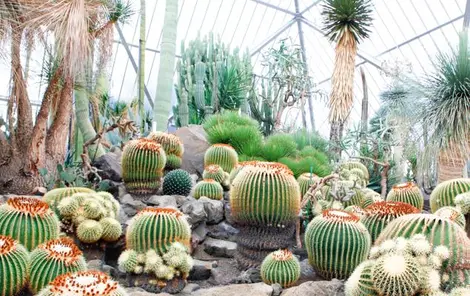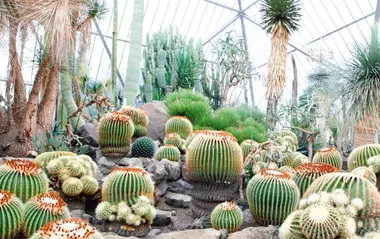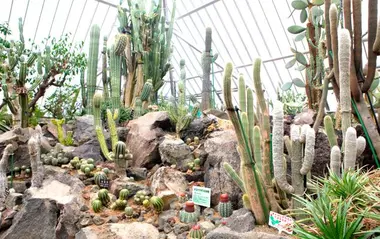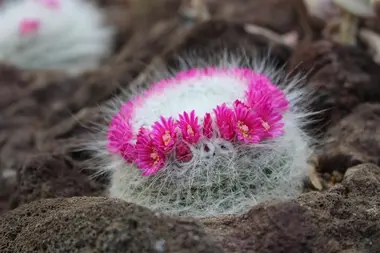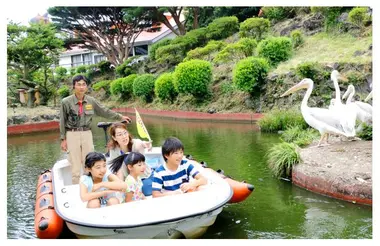Izu Shaboten Zoo 伊豆シャボテン動物公園
- Published on : 25/09/2018
- by : J.R.
- Youtube
Blooming cactus and exotic animals
On the Izu Peninsula, not far from Mount Fuji, the surprising Izu Shaboten Zoo is home to tropical plants, monumental statues, and exotic animals!
The zoo is located east of the Izu Peninsula. It is a pleasant stopover with the family or for animal lovers if you are crisscrossing the peninsula by car. It is also accessible by public transport from Tokyo, in less than 3 hrs.
Rent a car with Japan Experience.
The zoo is particularly renowned for its cacti ( shaboten in Japanese) and some of the animal species it hosts. On more than 20 hectares, young and old can discover many plants and animals from the four corners of the globe. Visitors can find 140 species of animals in the zoo section and 1,500 varieties of cacti and succulents distributed in 5 large greenhouses. The park is designed on the theme of Mexico, and giant statues of Native American inspiration punctuate the visit.
See also: The famous Ueno Zoo.
A wide variety of animals
At the Izu Shaboten Zoo, the curious can discover many monkeys (chimpanzees, squirrel monkeys, spider monkeys), kangaroos, and species native to the African continent, such as meerkats, lemurs, fennecs, marabou storks, and Cape penguins.
South America is not to be outdone either with brand representatives: first the cabiai, the park's mascots, without forgetting the llamas, the tapirs, the sloths, the peccaries, and many others. The course allows you to observe many exotic birds such as the elegant pink flamingos, magnificent macaws, black swans, or even bicorn hornbills. Otters, turtles, ponies, porcupines, peacocks... the list goes on as the zoo residents are numerous and varied!
The star of the zoo
The show's highlight at Izu Shaboten Zoo is its most famous resident: the cabiai, also called capybara. This peaceful herbivorous, semi-aquatic animal is the largest rodent in the world. In its natural state, it lives in South America: it is, therefore, exceptional to observe it in Japan. Harmless, despite their size, it is possible to pet them and even feed them. In winter, you can attend a very popular spectacle: the bath of the cabiai, which takes place twice a day on weekends and once a day on weekdays.
Cacti madness
The cacti are distributed in 5 pyramidal greenhouses for each geographical area: Mexico, Madagascar, Africa, America, and finally, the "jungle" greenhouse housing cacti and owls. Depending on the year, certain rare species can be admired in full bloom. Huge, these greenhouses allow you to admire a fascinating variety of species gathered in the same place and sometimes reaching impressive sizes. Beautiful succulents such as agaves or Aloe vera also rub shoulders with cacti.
To discover: Japanese parks and gardens.
Fun activities and shows
Those in a hurry will be content to stroll along the standard course that can be completed in an hour. Various activities are offered for those who wish to linger a bit: first, a beautiful guided boat trip that allows you to weave along the river between the monkey and lemur islands. Exhibition halls will enable you to meet the animals as closely as possible. You can feed the famous cabiai there, lemurs, llamas, chimpanzees, turtles, and many others... The spider monkeys roam freely in the zoo, and you may thus have the chance to meet them up close during your visit!
See also: Animal cafes.
Finally, for the kawaii touch so appreciated by the Japanese, animal shows (dogs, monkeys, parrots, etc.) are held at fixed times three times a day in the auditorium.
To give you a good idea of the variety of animals and activities in the park, here is the short presentation video concocted by the zoo:
Address, timetable & access
Address
Phone
+81 0557-51-1111Timetable
From Tokyo, take the Tokaido Line to Atami, then the JR Ito Line to Ito Station. Finally, hop on a Tokai bus (35 min).Price
Adult price: 2300 yen ($19/15€) Child price: under 4 years old, 400 yen ($3.25/3€), then 1100 yen ($9.50/8€)Access
Open every day, from March to October from 9 am to 5 pm and from November to February from 9 am to 4 pm.Website
http://izushaboten.com/lang/index.html





